Dinengdeng: Filipino soup with fried fish
A hot soup with lots of leafy vegetables and scrumptious fried fish is the perfect simple dish if you want to try tasty Filipino food.
This dish is called dinengdeng, and it’s easy to make at home.
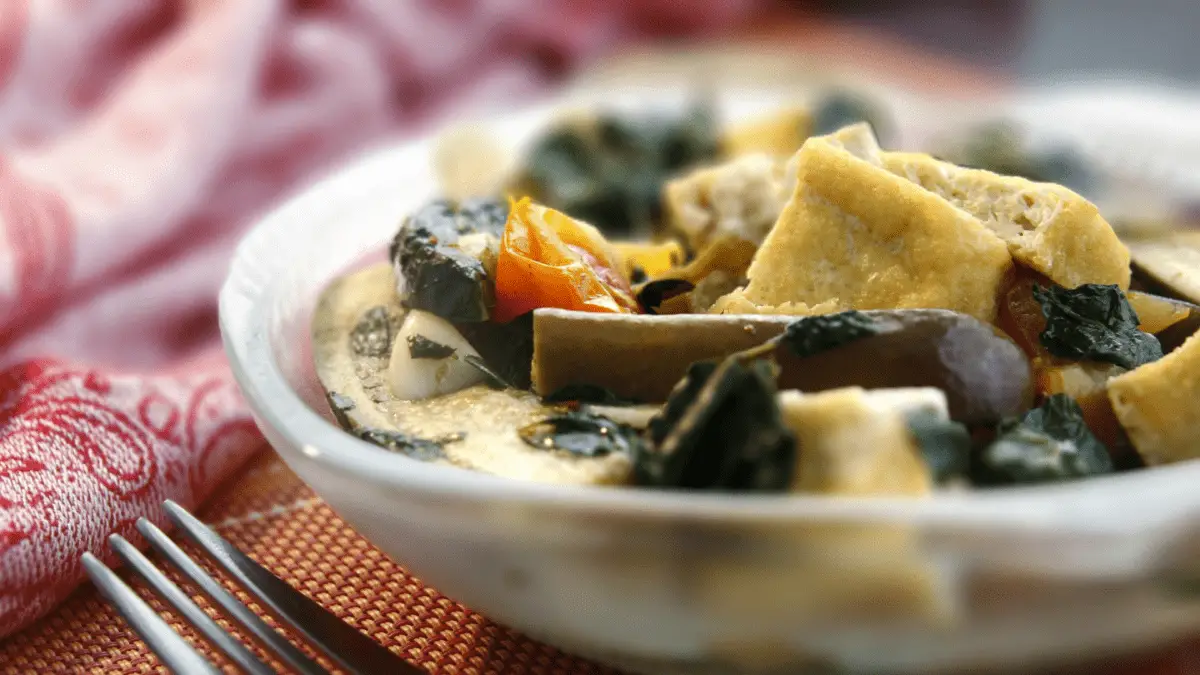
The key to a good dinengdeng is in the broth, which is made with rice wash water. Adding lots of veggies will make the broth flavorful, and the fried fish will add a nice crunch.
Although you can make dinengdeng with fried or grilled fish, this recipe uses fried fish because I feel like it adds extra flavor. Plus, the crispiness balances out the mushiness of the leafy greens!
In this post, you’ll learn how easy it is to make this dinengdeng recipe and its history. I’ll also share some variations and substitutions you can try.
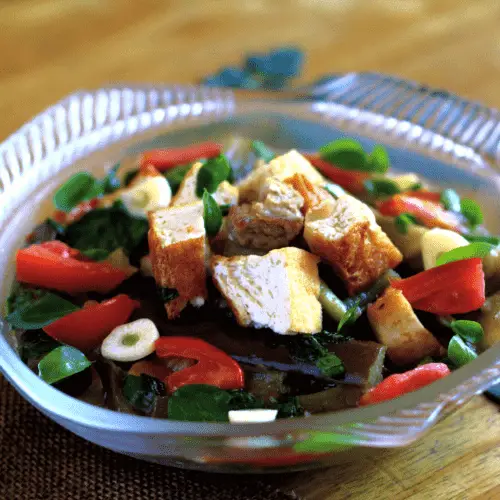

Check out our new cookbook
Bitemybun's family recipes with complete meal planner and recipe guide.
Try it out for free with Kindle Unlimited:
Read for freeIn this post we'll cover:
Fried fish dinengdeng recipe
Ingredients
- 3 pieces medium-sized bangus fish (milkfish) or seabass
- 10-12 pieces okra
- 1 medium onion chopped
- 1.5 cups kalabasa (squash flowers)
- 4 cups rice wash water
- 3 pieces ampalaya (bitter gourd) sliced
- 12 pieces sitaw (string beans or snake beans) chopped
- 2 medium ripe tomatoes chopped
- 2 cloves garlic minced
- 1 small piece ginger minced
- 1 cup hot pepper leaves (dahon ng sili)
- 1/2 cup labong (bamboo shoots)
- 3 tbsp bagoong monamon (anchovy paste)
- 1 tbsp salt
- 1/2 cup vegetable oil for frying fish
Instructions
- First, you have to prep the fish. Clean the fish and rub with salt.
- In a pot, add oil and start frying the fish until it turns golden brown. Next, turn over each fish and fry well. Once ready, remove and place aside for later use.
- Grab a clean pot and pour in the rice wash water. Allow it to boil.
- Now add onion, minced ginger, garlic, and the onion. Cover the pot and boil on medium heat for about 5 minutes.
- Add bagoong, okra, gourd, and bean, and cook between 8 to 12 minutes.
- Add bamboo shoots, hot pepper leaves, and the squash flower. Cook for an additional 3 or 4 minutes.
- Once ready, add the fried fish on top, put the lid on, and let it cook for 1 more minute.
- Transfer to serving bowls and serve hot.
Check out this video from YouTuber user Simpol to see dinengdeng being made:
Cooking tips
The goal when cooking dinengdeng with fried fish is to bring out all of the vegetables’ flavors, as well as the fish’s.
For even cooking, cut the vegetables as uniformly as possible.
Add vegetables depending on how long they take to cook. The slower ones should enter first, such as the harder vegetables. Since they cook the quickest, leafy vegetables should be added last. The bamboo shoots can be added last as well if they are already cooked.
The tomato, ginger, and onion are prepared first before the other vegetables because they take longer to cook.
In addition, I want to make sure that each vegetable is prepared to perfection while maintaining its aesthetic appeal. To accomplish this, add the non-leafy vegetables (okra, sitaw, and ampalaya) in the middle of the cooking period.
Cut the ampalaya into thin slices and soak them in water with a little salt to lessen its bitterness. Before cooking, allow it to sit for at least 20 to 30 minutes to eliminate most of the bitter flavor.
The fish, in addition to the bagoong monamon, is essential to the dish’s flavor. I often turn off the heat after 1 to 2 minutes of letting the fish boil with the vegetables.
By doing so, the liquid will be able to absorb the flavor of the fish.
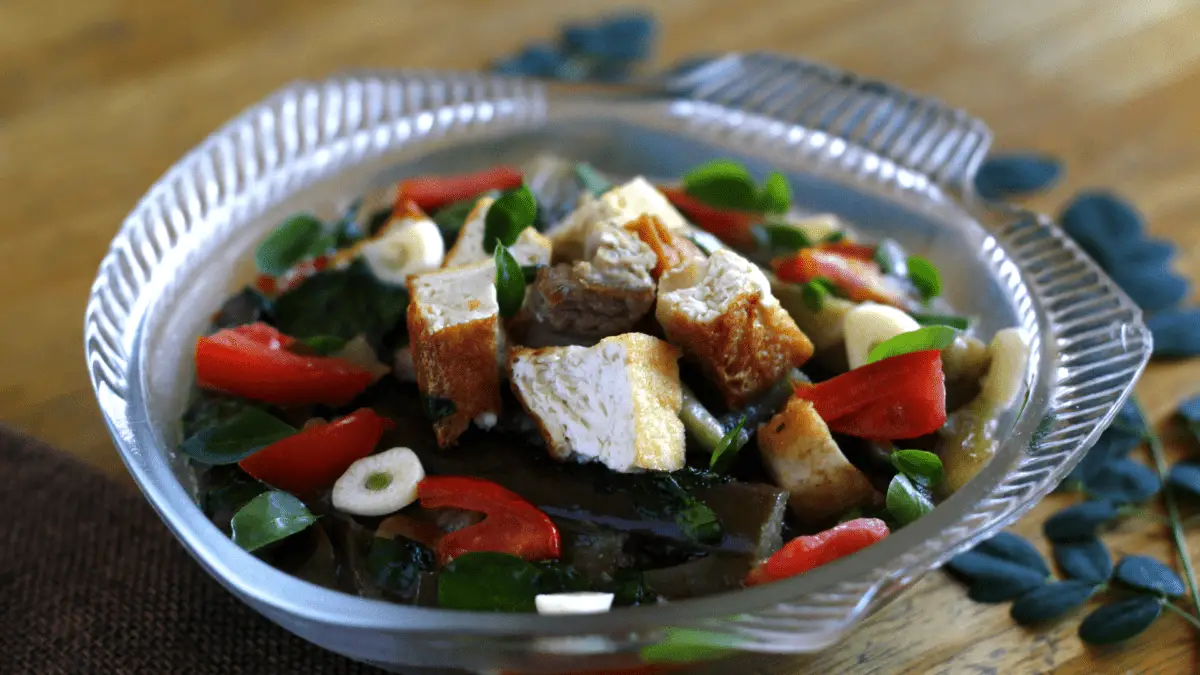
Keep in mind that the fish is partially submerged because it was positioned on top of the vegetables. This will add flavor to your dish while preserving the fried fish’s texture, so you should eat the top part first if you want that crunchiness.
Add only a little salt because the bagoong paste can be quite salty and overwhelming.
It’s best to use the leftover water from washing rice. You can always add more water if you feel like the broth is too thick.
Substitutes and variations
You can use any number of Filipino vegetables for this soup.
For example, jute leaves (saluyot), taro leaves (gabi), alugbate (Malabar spinach), and water spinach (kangkong) are all good leafy vegetable substitutes. If you can’t find these veggies, just add spinach.
Bitter melon or bitter gourd (ampalaya), eggplant (talong), and upo (bottle gourd) are also good choices for non-leafy veggies. People like to add sweet potato too, because it makes the soup richer.
Bamboo shoots and okra are also important, but you can combine all kinds of fresh vegetables you have on hand. String beans, snake beans, and yard-long beans (sitaw) are all good choices. Some people like to add malunggay leaves (moringa) to this soup as well.
When it comes to the fish, some people prefer dinengdeng with fried fish whereas others like grilled fish.
The traditional local fish is called bangus or milk fish, but you can use seabass or tilapia.
As for the flavoring, bagoong monamon is the top choice, and it’s made from ground anchovies. If you think the taste is too intense, you can always dilute bagoong.
If you can’t find it, you can use bagoong alamang (shrimp paste), which is also a good substitute and has a similar umami taste.
Bagoong isda (fish paste) is another good alternative. Even simple fish sauce works too!
What is dinengdeng?
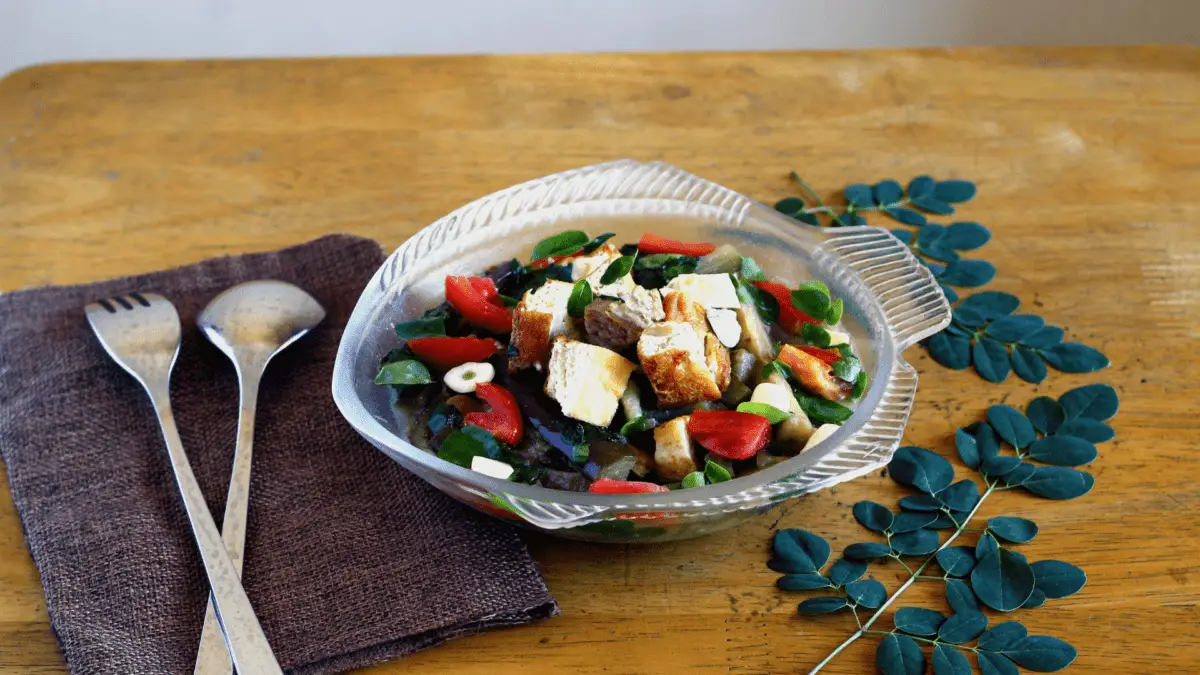
Dinengdeng is a type of Filipino vegetable soup that’s cooked with various vegetables and fish. There are a few local variations and some parts of the country have their own unique twist on this dish.
It’s also known as inabraw in some areas, and the term actually refers to the cooking process rather than the dish itself.
The most common vegetables used in dinengdeng are okra, ampalaya (bitter gourd), kalabasa (squash flowers), sitaw (string beans or snake beans), and labong (bamboo shoots).
The soup is usually cooked with bagoong monamon (anchovy paste) or bagoong alamang (shrimp paste) to add a salty and savory flavor.
Grilled or fried fish is added, and it becomes a very hearty meal.
It’s a popular dish among Filipinos and is often served during gatherings or special occasions.
Origin
Dinengdeng is originally from the Ilocos region in the Philippines. It’s believed to have originated in the pre-colonial era when people added grilled or crispy fried fish to soup to make it more nutritious.
This Ilocano dish is believed to be influenced by other similar dishes, like bulanglang (from Batangas).
It’s a popular dish in every Filipino region and is often made with vegetables that are grown in the area.
How to serve and eat
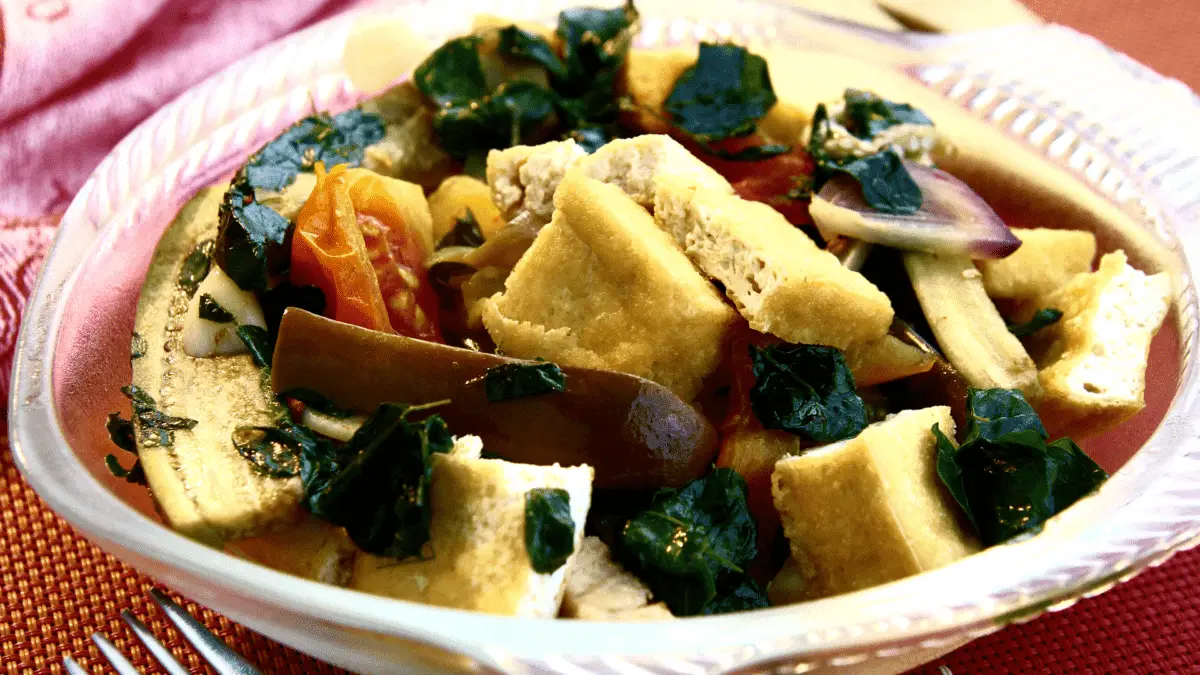
It’s best to serve hot dinengdeng with fresh fried fish in a large serving bowl with plenty of broth.
The fish is usually placed on top of the vegetables so that it doesn’t get overcooked and maintains its crispiness.
The soup can be eaten with steamed white rice or enjoyed on its own.
When eating, be careful of the hot soup and use a spoon to scoop out some of the broth first before adding the vegetables and fish to your bowl.
You can also eat it with extra servings of bagoong (anchovy paste) or patis (fish sauce).
Similar dishes
There are many similar Filipino broth dishes. Bulanglang is a type of soup that’s made with vegetables, but it doesn’t usually have fish. It’s basically the same soup, minus the fish!
Pinakbet is another type of soup that’s made with vegetables, but it uses a different type of fish called tilapia. Tinola is also similar to dinengdeng, but it uses chicken instead of fish.
Then there are some other Filipino soups that are more different but still tasty.
For example, sinigang is a soup that’s made with tamarind broth and various vegetables. It can also be made with different meats, such as chicken, pork, shrimp, or beef.
Bulalo is another Filipino soup that’s made with beef shanks and bone marrow. The soup is usually very hearty and pretty nutritious.
How to store and reheat
You can store leftovers in the fridge for up to 3 days in an airtight container.
Reheat on the stove over medium heat until piping hot.
You may need to add a little water to thin out the soup since it’ll thicken as it cools down.
FAQs
What is the difference between dinengdeng and inabraw?
The term “inabraw” refers to the cooking process, while “dinengdeng” is the actual dish.
Inabraw means “to cook with water” in Ilocano, and this cooking method is often used for dishes that are made with vegetables.
So technically, all dinengdeng is inabraw, but not all inabraw is dinengdeng.
What type of fish can I use for dinengdeng?
The most common type of fish used for dinengdeng is milkfish (bangus), but you can really use any type of fish that you like.
Some people also use seabass, seabream, tilapia, catfish, or even salmon. Just make sure that the fish is fresh and properly cleaned before cooking!
How do I clean the fish for dinengdeng?
Cleaning fish can be a bit tricky, but here are some tips to make it easier.
First, remove the scales by scraping them off with a knife. You can also use a fish scaler if you have one.
Next, cut off the head and tail of the fish.
Then, make a slit along the belly and remove the guts. Rinse the fish inside and out with cold water.
Finally, cut the fish into desired pieces and set aside until ready to use.
What vegetables can I use for dinengdeng?
The most common vegetables used for dinengdeng are eggplant, okra, amaranth leaves, and squash. But you can really use any type of vegetables that you like or have on hand.
Some people also add sitaw (string beans), bok choy, sweet potatoes, cabbage, or even carrots.
You can customize the dinengdeng recipe to make it more suitable for what you have in your pantry.
Is dinengdeng healthy?
Like other fried dishes, it’s the fried fish that takes away the healthy aspects of this dish.
But overall, dinengdeng is actually a pretty healthy dish because it’s made with vegetables and fish.
The vegetables are a good source of fiber, vitamins, and minerals, while the fish is a good source of protein and omega-3 fatty acids.
This soup is low in saturated fat and calories, and it’s also gluten-free.
Make a pot of dinengdeng tonight
Dinengdeng can be eaten with steamed white rice or enjoyed as is when you’re just craving a bowl of hot comfort food.
This recipe is a great way to enjoy 2 Filipino favorites: fried fish and savory broth! So the next time you want something healthy and soothing, make a pot of dinengdeng.
Recommended Reading
Check out our new cookbook
Bitemybun's family recipes with complete meal planner and recipe guide.
Try it out for free with Kindle Unlimited:
Read for freeJoost Nusselder, the founder of Bite My Bun is a content marketer, dad and loves trying out new food with Japanese food at the heart of his passion, and together with his team he's been creating in-depth blog articles since 2016 to help loyal readers with recipes and cooking tips.
